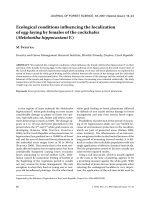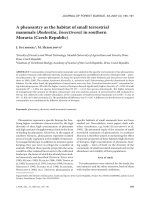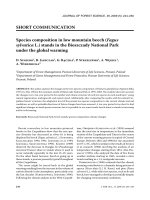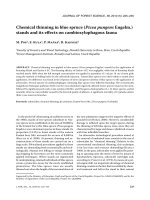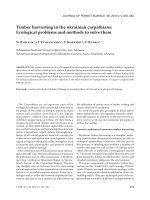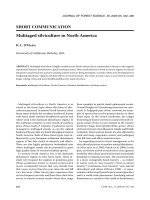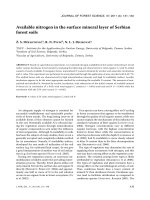Báo cáo lâm nghiệp: "Compression stress in opposite wood of angiosperms: observations in chestnut, mani and poplar" ppsx
Bạn đang xem bản rút gọn của tài liệu. Xem và tải ngay bản đầy đủ của tài liệu tại đây (102.82 KB, 4 trang )
Ann. For. Sci. 63 (2006) 507–510 507
c
INRA, EDP Sciences, 2006
DOI: 10.1051/forest:2006032
Original article
Compression stress in opposite wood of angiosperms: observations
in chestnut, mani and poplar
Bruno C
a,b
*
, Tancrède A
c
, Junji S
a
a
Laboratory of Biomass Morphogenesis and Information, Research Institute for Sustainable Humanosphere, Kyoto University,
Uji-Kyoto 611-0011, Japan
b
Laboratoire de Mécanique et Génie Civil (LMGC), UMR 5508 CNRS, Université Montpellier 2, Place E. Bataillon, CC 48,
34095 Montpellier Cedex 5, France
c
Laboratory of Bio-Material Physics, Graduate School of Bioagricultural Sciences, Nagoya University, Nagoya 464-8601, Japan
(Received 24 May 2005; accepted 13 December 2005)
Abstract – In order to face environmental constraints, trees are able to re-orient their axes by controlling the stress level in the newly formed wood
layers. Angiosperms and gymnosperms evolved into two distinct mechanisms: the former produce a wood with large tension pre-stress on the upper
side of the tilted axis, while the latter produce a wood with large compression pre-stress on the lower side. In both cases, the difference between this
stress level and that of the opposite side, in light tension, generates the bending of the axis. However, light values of compression were sometimes
measured in the opposite side of angiosperms. By analysing old data on chestnut and mani and new data on poplar, this study shows that these values
were not measurement artefacts. This reveals that generating light compression stress in opposite wood contributes to improve the performance of the
re-orientation mechanism.
reaction wood / compression wood / tension wood / opposite wood / plant biomechanics / growth stresses / microfibrils angle
Résumé – Contraintes de compression dans le bois opposé des angiospermes : observation chez le châtaignier, le manil et le peuplier. Pour
s’adapter à l’environnement, les arbres sont capables de contrôler l’état de contraintes des nouvelles couches de bois formé pour réorienter leurs
axes. Angiospermes et gymnospermes ont évolué vers deux stratégies différentes : les premiers produisent un bois à forte précontrainte de tension
sur la face supérieure de l’axe incliné alors que les derniers mettent en place un bois en précontrainte de compression sur la face inférieure. La
différence de contrainte avec la face opposée constituée de bois en légère tension produit un même résultat, la flexion de l’axe. Pourtant, au hasard des
expérimentations, des valeurs de compression ont plusieurs fois été observées dans le bois opposé des angiospermes. Cette étude reprend des donnés
anciennes sur le châtaignier et le manil et les complète avec des données sur peuplier pour mettre en évidence qu’il ne s’agit par d’erreurs de mesure
mais réellement d’une stratégie de ces arbres consistant à produire du bois en légère précontrainte de compression pour une meilleure efficacité du
redressement.
bois de réaction / bois de compression / bois de tension / bois opposé / biomécanique végétale / contraintes de croissances / angle des microfibrilles
1. INTRODUCTION
During their development, trees are submitted to various
mechanical constraints that may cause a permanent change in
the orientation of their stem and branches. These constraints
are environmental, such as soil instability or damage due to
the action of wind or snow, as well as biological, such as the
weight of epiphytes or the weight of the stem and crown of
the tree itself. Controlling and correcting the orientation of
woody axes is then necessary for a tree to adapt to its environ-
ment, ensure its long-term mechanical stability and maximise
its chances to survive and reproduce.
This morphological plasticity is achieved through the pro-
duction of reaction wood on one side of the stem [23]. Reac-
tion wood is characterised by a high magnitude of the longitu-
dinal stress generated within wood cells walls during matura-
* Corresponding author:
tion. The asymmetric distribution of maturation stress within
the newly formed layers of a stem cross-section creates a bend-
ing moment resulting in a change in stem curvature [2, 3,15].
Gymnosperm and angiosperm species have specific mech-
anisms for generating this bending moment. Gymnosperms
produce compression wood in the lower side of the tilted
stem and angiosperms produce tension wood in the upper
side [3, 5, 14, 15, 20, 25, 27]. In both cases the opposite side
is characterised by a “normal” stress, i.e. a light tension.
Because of the stiffness of the internal wood layers, most
of the maturation stress in the outer layers of the tree is not
released in situ [3]. This can be evidenced and quantified by
releasing the longitudinal stress at the surface of wood and
measuring the resulting strain, referred to as residual growth
strain (RGS). Typical RGS values range from –0.1% to –0.4%
for tension wood (TW), from –0.015% to –0.1% for nor-
mal wood (NW) and from +0.05% to +0.3% for compression
wood (CW) [15].
Article published by EDP Sciences and available at or />508 B. Clair et al.
Positive RGS values were sometimes measured in an-
giosperm opposite wood [10, 11]. These values were be-
lieved to be measurement artefacts. Indeed, metrological stud-
ies showed that the methods for measuring RGS may have a
non-negligible incertitude [15, 30]. Also, other sources of me-
chanical stress are a possible cause of error for the estima-
tion of maturation stress. Any increment of load or change in
stem orientation generates an additional stress field inside the
tree, referred to as support stress. Growth stress is the sum of
maturation stress and support stress. It can be shown that the
support stress is low in peripheral wood layers, and generally
much lower than maturation stress of reaction wood [3]. How-
ever, in certain conditions, it may not be negligible so that the
measurement of RGS, even if accurate, is a biased estimation
of the maturation strain. This bias may not be negligible when
compared to the magnitude of RGS in normal wood.
Recently, performing research on tension wood of species
well known to produce high tension stress, some positive RGS
values were measured on the opposite side (lower side) of the
tilted trees [10, 11]. In this paper, by considering other physi-
cal and micro-structural features usually correlated to the RGS
value, we aim at verifying if these measurements were arte-
facts or if angiosperms develop compression maturation stress
in opposite wood to improve the biomechanical performance.
2. MATERIALS AND METHODS
Studies were performed on tilted trees of chestnut (Castanea
sativa Mill.), mani (Symphonia globulifera L.f.) and poplar (Populus
euramericana Guinier). Diameters at breast height were respectively
15 cm, 20 cm and 25 cm. Chestnuts were growing in a private forest
in south of France, mani in a tropical rainforest in French Guyana
(South America) and poplar in Kyoto university experimental forest
(Japan). Experiments on mani and chestnut involved measurements
of RGS and longitudinal drying shrinkage, and were presented in de-
tails in previous papers [10, 11]. New data on poplar are also shown,
including measurements of RGS and micro-fibril angle.
2.1. Residual growth strain (RGS)
Various methods are available for measuring RGS. They are
based on the same principle, which consists in measuring the lon-
gitudinal strain at the wood surface, after artificially releasing the
stress [15,30]. For chestnuts and mani, the “single hole” method was
used [11, 15]. With this method, a displacement is measured (in m)
and converted into a strain (in %) using a calibration factor. Em-
pirical and theoretical calibration factors were provided by Fournier
et al. [15]. We used the factor 12.3× 10
−4
corresponding to a standard
hardwood. For poplar experiments, RGS was directly obtained using
the strain gauge method described by Yoshida and Okuyama [30].
In the three species, RGS were measured at various positions
around the circumference. For each RGS measurement, several mea-
surements of the other feature were performed, at various locations
close to the point where RGS were measured.
Figure 1. Longitudinal shrinkage measured on chestnut samples ver-
sus the residual growth strain. Full circle: normal and “compression”
wood. Empty circle: tension wood (modified from [11]).
2.2. Longitudinal shrinkage
The length of chestnuts sample (R × T × L = 1 × 5 × 50 mm
3
)and
the thickness of a mani disk (L = 50 mm) were measured in green
and oven-dried condition with a Mitutoyo transducer. Shrinkage was
calculated as the dimensional variation between green and dry states,
divided by the dimension in the green state [10, 11].
2.3. Microfibrils angle (MFA)
MFAs were measured in green conditions. A plain sawn plate
(R × T × L = 2 × 0.5 × 20 mm
3
) was mounted in a fibre goniome-
ter, keeping θ–2θ to satisfy the Bragg condition of (004) meridional
planes. The intensity distribution was then recorded by rotating the
sample with a speed of 6
◦
/min. The CuK (λ = 0.1542 nm) were gen-
erated by X-ray generator (RIGAKU Ultra18HF) operated at 30 kV,
300 mA. Parameter T defined by Cave [7] was graphically derived
from the diffraction intensity diagrams. The average MFA of each
sample was estimated using Cave’s formula: MFA = 0.6×T. As stated
by Cave [8], the intensity diagram obtained from the (004) plane is
identical to that obtained from the (200) plane, but suffers contam-
ination from other weak crystalline planes having a similar Bragg
angles. Considering that this contamination is low, parameter T gives
useful estimations of the MFA. Also, application of Cave’s formula
for wood samples having a MFA lower than 20
◦
is subject to discus-
sion. Values obtained using the “improved Cave’s method” [28] were
also computed to check the consistency of the results.
3. RESULTS AND DISCUSSION
Figures 1 and 2 show the longitudinal shrinkage measured
on chestnut and mani versus the RGS. Results on tension wood
are presented in order to show the ability of these trees to pro-
duce high tensile stressed wood, having a high longitudinal
shrinkage, as it is well known [9,13,17,22]. Observation of the
measured longitudinal shrinkage versus RGS shows a contin-
uum in behaviour from the “normally” tensile stressed wood
to the compression stressed wood. Inside the group of nor-
mal wood samples (including compression values), RGS and
longitudinal shrinkage are significantly correlated (R = 0.60,
Compression wood in angiosperms 509
Figure 2. Longitudinal shrinkage measured on mani disks versus the
approximate residual growth strain. Full circle: normal and “com-
pression” wood. Empty circle: tension wood.
Figure 3. Microfibrils angle estimated on poplar samples versus the
residual growth strain. Full circle: normal and “compression” wood.
Empty circle: tension wood.
p < 0.001 for chestnut, R = 0.59, p < 0.05 for mani). More-
over, the mean longitudinal shrinkage of samples with positive
RGS is significantly higher than that of normal wood sam-
ples having negative RGS (Mann-Whitney U test, p < 0.01
for chestnut, p < 0.05 for mani). This tendency is similar to
that observed in gymnosperms in the transition between nor-
mal and compression wood [24,26].
Figure 3 shows the relation between MFA estimation and
RGS for poplar. Results obtained on tension wood are pre-
sented in order to confirm the capacity of this tree to generate
high tension stresses associated with a very low MFA
1
, as typ-
ically found in gelatinous fibres [16]. For samples with RGS
higher than –0.1%, there is a general trend for the MFA to
increase with the RGS. Inside the group or normal wood sam-
ples (including compression values), RGS and MFA are sig-
nificantly correlated (R = 0.67, p < 0.005). The mean MFA of
samples with positive RGS is significantly higher than that of
normal wood samples having negative RGS (Mann-Whitney U
test, p < 0.001). Again, this tendency is typical of the relation
1
Values around 5
◦
found for tension wood MFA should not be con-
sidered as a correct estimate, since the Cave’s method [7] used to
derive the MFA from the diffraction diagram is not adapted to such
low values. Using Yamamoto’s improved method [28], negative val-
ues ranging between –1
◦
and –5
◦
were obtained. The real mean value
of MFA in tension wood is probably close to 0
◦
.
observed in gymnosperms from normal wood to compression
wood [18,26].
On the three angiosperms species studied, positive values of
RGS between +0.01% and +0.02% were found. Each time, the
values of other features positively correlated to the RGS were
found consistently higher in samples with positive RGS. This
clearly confirms that the observed positive RGS are not due
to measurement errors, but really correspond to a compressive
maturation stress.
In the case of poplar, our measurements show that wood
with compression maturation stress have higher MFA than typ-
ical normal wood. Unfortunately, the MFA of chestnut and
mani samples were not measured. However, several experi-
mental and theoretical works showed that the increase in lon-
gitudinal shrinkage from normal to compression wood is due
to the increase of the MFA [18, 26], so that it is likely that a
similar observation would have been done on these species.
Several works showed that development of compressive mat-
uration stress is a direct mechanical consequence of this large
MFA [1, 6, 29].
Even if the RGS value of this wood is lower than that of
typical CW of gymnosperms, similar features were observed,
concerning the cell structure (MFA), the physical behaviour
(shrinkage) and the biomechanical behaviour (RGS). For all
features, this opposite wood of angiosperm seems to be an
intermediate form between normal wood and typical com-
pression wood, maybe similar to what was observed in gym-
nosperms in the transition zone between these two tissues [31].
The presence of CW in angiosperms was previously
reported, to our knowledge, only for the case of Buxus
(microphylla and sempervirens) [4, 20, 32] and other prim-
itive angiosperms such as Pseudowintera colorata (Winter-
aceae) [19]. In the case of these species, the magnitude
of RGS, anatomical observations and/or chemical analyses
showed that typical CW was produced close to CW of gym-
nosperms [4, 19, 32]. This particular case clearly differs from
the results of our study from a biomechanical point of view. In-
deed, the biomechanical mechanism of Buxus and Pseudowin-
tera is completely similar to that of gymnosperms, producing
CW with stem eccentricity in the lower side associated and
NW in the opposite side.
Trees studied in this paper seem to cumulate advantages of
angiosperms and gymnosperms by combining the production
of strong TW on one side and a kind of light CW on the oppo-
site side.
Values of RGS in tension wood measured for many species
suggest that there may be an upper limit in the tensile stress
that can be generated in wood cell walls [12, 21]. In this case,
the biomechanical performance of the re-orientation process
can only be improved through complementary mechanisms.
Difference in stiffness between NW and TW or stem eccentric
growth are known examples of such complementary mecha-
nisms [2]. The simultaneous production of TW on the upper
side and CW in the lower side is an additional mechanism,
which allows a substantial improvement of the biomechani-
cal performance. Indeed, the change in curvature induced by
reaction wood production is roughly proportional to the dif-
ference in RGS between the two sides. For our samples, this
510 B. Clair et al.
difference was increased by 17% to 38% because light com-
pression wood was produced on the opposite side instead of
typical normal wood.
4. CONCLUSION
On these three angiosperms species, light compression
wood was found in the opposite side of tension wood. Some
more investigation, especially on the chemical composition
and the anatomical structure, would be interesting to show
whether this angiosperm compression wood differs or not
from gymnosperm compression wood. In these trees, the re-
orientation was produced by the cumulative effect of a high
tension stress in the upper side of the tilted stem and a low
compression stress in the lower side. Combining these two re-
actions seems to be the best way for improving the biomechan-
ical reactivity of the tree.
Acknowledgements: Authors thank Pr. Tanaka for his kindness in
the use of X-ray machine and G. Jaouen for shrinkage measure-
ments on mani. Experiments on mani were performed in the labora-
tory “Écologie des Forêts de Guyane” (UMR CIRAD – ENGREF –
INRA 745– CNRS 2728) in Kourou (French Guyana) under the su-
pervision of Pr. Meriem Fournier. The study was supported by the
Ademe and the French Ministry of Agriculture in the framework of
a project on “Physical and mechanical properties of reaction woods”
(convention 61.45.47/00) and by a Grant in Aid for Scientific Re-
search from the Japanese Society of Promotion of Science (Nos.
14656069, 14360099, 14002805). First and second authors received
post-doctoral fellowship from Japanese Society for Promotion of Sci-
ences (JSPS).
REFERENCES
[1] Alméras T., Gril J., Yamamoto H., Modelling anisotropic strains in
wood in relation to fibre boundary conditions, microstructure and
maturation kinetics, Holzforschung 59 (2005) 347–353.
[2] Alméras T., Thibaut A., Gril J., Effect of circumferential hetero-
geneity of wood maturation strain, modulus of elasticity and ra-
dial growth on the regulation of stem orientation in trees, Trees 19
(2005) 457–467.
[3] Archer R.R., Growth stresses and strains in trees, Springer-Verlag,
Berlin Heidelberg New-York, 1986.
[4] Baillères H., Castan M., Monties B., Pollet B., Lapierre C., Lignin
structure in Buxus sempervirens reaction wood, Phytochemistry 44
(1997) 35–39.
[5] Barnett J.R., Jeronimidis G., Reaction wood, in: Barnett J.R.,
Jeronimidis G., Roberts A., Usherwood P.N.R. (Eds.), Wood qual-
ity and its biological basis, Blackwell Publishing, Oxford 2003, pp.
118-136.
[6] Boyd J.D., Tree growth stresses – Part V: Evidence of an origin in
differentiation and lignification, Wood Sci. Technol. 6 (1972) 251–
262.
[7] Cave I.D., Theory of X-ray measurement of microfibril angle in
wood, For. Prod. J. 16 (1966) 37–42.
[8] Cave I.D., Theory of X-ray measurement of microfibril angle in
wood, Part 2: the diffraction diagram, Wood Sci. Technol. 31 (1997)
225-234.
[9] Chow K.Y., A comparative study of the structure and composition
of tension wood in beech (Fagus sylvatica L.), Forestry 20 (1946)
62–77.
[10] Clair B., Jaouen G., Beauchêne J., Fournier M., Mapping radial, tan-
gential and longitudinal shrinkages and its relation to tension wood
in discs of the tropical tree Symphonia globulifera, Holzforschung
57 (2003) 665–671.
[11] Clair B., Ruelle J., Thibaut B., Relationship between growth
stresses, mechano-physical properties and proportion of fibre with
gelatinous layer in chestnut (Castanea sativa Mill.), Holzforschung
57 (2003) 189–195.
[12] Clair B., Ruelle J., Beauchêne J., Prevost M.F., Fournier M.,
Tension wood and opposite wood in 21 tropical rain forest species.
1. About the presence of G layer, IAWA J. 27 (2006) (in press).
[13] Clarke S.H., The distribution, structure and properties of tension
wood in beech (Fagus sylvatica L.), J. For. 11 (1937) 85–91.
[14] Coutand C., Jeronimidis G., Chanson B., Loup C., Comparison
of mechanical properties of tension and normal wood in Populus,
Wood Sci. Technol. 38 (2004) 11–24.
[15] Fournier M., Chanson B., Thibaut B., Guitard D., Mesure des défor-
mations résiduelles de croissance à la surface des arbres, en relation
avec leur morphologie. Observation sur différentes espèces, Ann.
Sci. For. 51 (1994) 249–266.
[16] Fujita M., Saiki H., Harada H., Electron microscopy of micro-
tubules and cellulose microfibrils in secondary wall formation of
poplar tension wood fibers, Mokuzai Gakkaishi 20 (1974) 147–156.
[17] Jourez B., Riboux A., Leclercq A., Comparison of basic density
and longitudinal shrinkage in tension wood and opposite wood in
young stems of Populus euramericana cv. Ghoy when subjected to
a gravitational stimulus, Can. J. For. Res. 31 (2001) 1676–1683.
[18] Meylan B.A., The Influence of microfibril angle on the longitudi-
nal shrinkage-moisture content relationship, Wood Sci. Technol. 6
(1972) 293–301.
[19] Meylan B.A., Reaction wood in Pseudowintera colorata – A vessel-
less dicotyledon, Wood Sci. Technol. 15 (1981) 81–92.
[20] Onaka F., Studies on compression and tension wood, Wood Res. 1
(1949) 1–88.
[21] Ruelle J., Clair B., Beauchêne J., Prevost M.F., Fournier M.,
Tension wood and opposite wood in 21 tropical rain Forest species.
2. Comparison of some anatomical criteria, IAWA J. 27 (2006)
(in press).
[22] Sassus F., Déformations de maturation et propriétés du bois de ten-
sion chez le hêtre et le peuplier : mesures et modèles, Ph.D. thesis,
Engref, Montpellier, 1998.
[23] Sinnott E.W., Reaction wood and regulation of tree form, Am. J.
Bot. 39 (1952) 69–78.
[24] Skaar C., Wood-water relations, Springer Verlag, Berlin,
Heidelberg, New York, 1988.
[25] Thibaut B., Gril J., Growth stresses, in: Barnett J.R., Jeronimidis
G.J., Roberts A., Usherwood P.N.R. (Eds.), Wood quality and its
biological basis, Blackwell Publishing, Oxford 2003, pp. 137–156.
[26] Timell T.E., Compression wood in Gymnosperms, Vol. 1:
Bibliography, historical background, determination, structure,
chemistry, topochemistry, physical properties, origin,and formation
of compression wood, Springer Verlag, Berlin, Heidelberg, New
York, 1986.
[27] Wilson B.F., Archer R.R., Tree design: some biological solutions to
mechanical problems, Bioscience 9 (1979) 293–298.
[28] Yamamoto H., Okuyama T., Yoshida M., Method for determining
the mean microfibril angle of wood over a wide range by the im-
proved Cave’s method, Mokuzai Gakkaishi (1993) 375–381.
[29] Yamamoto H., Generation mechanism of growth stresses in wood
cell walls: roles of lignin deposition and cellulose microfibril during
cell wall maturation, Wood Sci. Technol. 32 (1998) 171–182.
[30] Yoshida M., Okuyama T., Techniques for measuring growth stress
on the xylem surface using strain and dial gauges, Holzforschung
56 (2002) 461–467.
[31] Yoshizawa N., Idei T., Some structural and evolutionnary aspects of
compression wood tracheids, Wood Fiber Sci. 19 (1987) 343–352.
[32] Yoshizawa N., Satoh M., Yokota S., Idei T., Formation and structure
of reaction wood in Buxus microphylla var. insulari Nakai, Wood
Sci. Technol. 27 (1993) 1–10.
